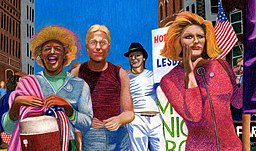1.Our Theme This Week: #Stonewall50
June in the U.S. is LGBTQ+ Pride Month, chosen to commemorate the Stonewall riots that took place starting June 28th, 1969. On the show our theme was #Stonewall50, which the LGBTQ+ community and allies have been using to mark 50 years since the riots.
When we featured the topic #Pride last year on SNS Eigojutsu (which is an English language learning show), we were careful to add as much nuance as possible and illuminate context. (In my entry on that episode, LANGUAGE & EDUCATION #007, I went over the nuances of terms like “gay” and “out of the closet”.)
For example, the Q in LGBTQ+ stands for both “queer” (an umbrella term for someone in the sexual minority) and “questioning” (a person who is exploring their sexual orientation). “Queer” is a term that originally meant “strange”, and was used as a derogatory term for homosexual men. However, in recent years, people in the LGBTQ+ community have reclaimed the word as a term of pride. That being said, it is important to note that people who are not LGBTQ+ should refrain from using the term without careful consideration of context. Without an understanding of the history behind words and a grasp of the nuances both past and present, you run the risk of inadvertently offending—or saying something offensive. On our #Stonewall50 episode, resident English teacher Torikai-sensei managed to talk a little bit about those subtleties.
2.A Word About English LGBTQ+ Terms and Nuances
One of the main ideas put forth by the LGBTQ+ movement is the diversity of sexual orientation and gender among humans. The movement calls into question our heteronormative beliefs (the idea that being heterosexual is the normal, or most favorable sexual orientation) and our gender norms (how society has taught us males and females should be or act).
This question of gender was salient in considering figures like Marsha P. Johnson and Silvia Rivera, two transgender activists who played a central role in the Stonewall riots.
For example, when referring to a transgender person, should we use the pronoun “he" or “she"? What if we don’t know the person’s preference? To make things more complicated (or perhaps less complicated, depending on how you look at it), the English Wikipedia entries on both Johnson and Rivera use the pronoun “she" exclusively. While the entries indicate that both were transgender, it isn’t explicitly noted whether they were born male or female. (Which poses challenges when trying to chart and fact-check their journey for a TV show such as ours.) Then again, perhaps that is the point. The LGBTQ+ movement has made sufficient progress that it has shaped the way we talk about people in the LGBTQ+ community; more and more we use language in line with how that person identifies themselves, rather than how their biology defined them at birth. Their voices have changed not only society but the English language.
What’s more, some have questioned why those who do not personally identify with their birth sex are called “transgender", while there is not equivalent term for someone who does identify with their birth sex. The argument is that it implies that being transgender is not normal. As a result, the term “cisgender" has come into use in the West in recent years to replace “straight", which some consider to imply that those who aren’t straight are “crooked". Trans- is a Latin prefix meaning “across from" or “on the other side of", while cis- means “on this side of"—in other words, alignment of gender identity with birth sex.
The term “cisgender" is not without its detractors. And it may surprise you to learn that many on the liberal left and in the LGBTQ+ community take issue with the term. They argue that when dividing people into transgender and cisgender, LGB people are usually grouped with the latter—which insinuates that they do not experience a similar dissonance. To put it another way, while the LGBTQ+ movement has fought to spread the idea that sexual orientation and gender identity are non-binary, classifying people as either transgender or cisgender imposes its own binary gender construction—and is thus counterproductive.
3.English Pronouns and Honorifics Today
The question of he/she is not exclusive to those who identify as LGBTQ+; it has been a long-standing point of contention when it comes to the English language. Traditionally, “he” was used as the standard generic third-person pronoun, but today, it is recognized as exclusive rather than inclusive of women—not gender-neutral. When I was growing up, we were taught in school to use “he or she” (or alternatively, use the pronoun “one”, or rewrite the sentence completely). Some opted to use “she or he” or “s/he” instead. In practice, each of these alternatives come with their own problems, and end up either sounding too formal or clunky.
The singular “they” has increasingly become the standard generic pronoun of the English language. As “they” is a third-person plural pronoun, we were generally taught in school that the singular “they” was ungrammatical. However, many have pointed out that the singular “they” has been used since the middle ages by many highly-regarded authors, including none other than William Shakespeare. Today, it has become generally accepted—at least in informal writing—as a gender-neutral alternative to “he” or “she”. Moreover, people in the West who do not identify as either male or female have begun embracing the term and saying as such when they introduce themselves.
Changing topics, standard honorifics in the English language include Mr., Mrs., and Ms. Mr. is for men, while Mrs. And Miss were used for women—the former for married women, and the latter for unmarried women. Today, that practice is considered old-fashioned and sexist, and Ms. has become the standard honorific for women.
Therein lies another problem: what honorific should be used for transgender people and those who identify as non-binary? (Non-binary refers to gender identities that are not exclusively masculine or feminine.) Enter Mx., pronounced mux or mix. The term is currently recognized on various official forms in the U.K., and while it has yet to catch on in the U.S., the term has been added to many English language dictionaries.
As sexual orientation and gender norms become more diverse in the West, the language at our disposal to describe identity has also diversified. Side note, Ms. was coined around 1901, but was not adopted by The New York Times (considered an authority on the English language) until 1986. Mx. was coined in the latter 1970s, and was added to Merriam-Webster Dictionary in 2016. (The New York Times has written articles about the honorific, but has not officially adopted it.)
4.In America, if You Don’t Speak Up, You Aren’t Acknowledged
In this piece I’ve talked about various terms embraced by the LGBTQ+ community to describe LGBTQ+ identity. The thought that the terms are as myriad as the LGBTQ+ experience itself can be daunting for learners of the English language. Truth be told, many native English speakers in America feel similarly overwhelmed. The important thing, however, is to recognize that there is a wide range of words used to describe sexual orientation and gender, and that underlying it all is American individualism.
An American custom emblematic of that individualism is the self-introduction. For example, “My name is Kazuo Peña. Call me Kazoo, like the wind instrument." A self-introduction is your chance to let your audience know what you’d like to be called. Take advantage of the opportunity, and most Americans will honor the request.
That courtesy is extended not just to a name or nickname, but whatever it is you want to voice about who you are and what you are about—the core of your identity. A transgender person could make it known that they prefer to be called “she", or they could request to be referred to using the singular “they". When your audience respects your request, it makes you feel seen, acknowledged as a human being.
Taking all of that into account, a word of advice for any Japanese person planning to travel to the U.S. or Europe, whether it be for pleasure, study, or business. When interacting with Westerners and introducing yourself, be memorable. So many Japanese tend to give innocuous, cookie-cutter, unmemorable self-introductions. Their go-to is to mention a hobby, but that hobby is inevitably unspecific, like “watching movies" or “reading books". Some dedicated workaholic types might even answer that they have no hobbies to speak of. From a Westerner’ s perspective, a weak introduction leaves a weak impression—or none at all.
When asked or given the chance, Americans are generally able to speak up and encapsulate who they are in a phrase or two. The key to a successful self-introduction is to visualize what kind of impression you’d like to leave, and how you want people to remember you. In other words, a self-introduction is a personal statement. And in order to say something about yourself, it is important to have the vocabulary, as well as a grasp of the nuances associated with those words. Someone who doesn’t speak up or has nothing to say is ignored, deemed unworthy of acknowledgment.
Members of the LGBTQ+ community hold a variety of events throughout Pride Month because they are aware that by making noise and making sure their voices are heard, they become unignorable. They are acknowledged as human beings.
5.My Wardrobe This Episode
Gray double-breasted suit jacket by Universal Language

Black suit pants by KASHIYAMA the Smart Tailor

I chose a mid-range black fabric with subtle black stripes, not quite as fancy as the higher-end ones I’ve been experimenting with recently, but a step above their lowest-priced options. Judging by the finished product, they’ve undersold and overdelivered.
This time around I wanted to try something a little different from the classic styles I’d had made before, so I requested something in a slimmer fit. Not only is the overall shape slimmer, the length of the jacket and the pants are on the shorter side. It feels very “current". The slim fit is certainly stylish, but I also can’t shake the feeling that the comfort inherent to a quality suit is being sacrificed for the sake of style.
Black button-down shirt by Shibuya Seibu

Brass cuff links by Kamakura Cuffs Koubou
“Reims" black loafers by Paraboot








